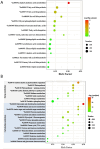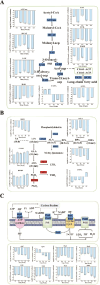Warming degrades nutritional quality of periphyton in stream ecosystems: evidence from a mesocosm experiment
- PMID: 40201424
- PMCID: PMC11977459
- DOI: 10.1093/ismeco/ycaf051
Warming degrades nutritional quality of periphyton in stream ecosystems: evidence from a mesocosm experiment
Abstract
Periphyton, which is rich in polyunsaturated fatty acids (PUFA), serves as an indispensable high-quality basal resource for consumers in stream food webs. However, with global warming, how fatty acid composition of periphyton changes and consequent effects on their transfer to higher trophic level consumers remain unclear. By carrying out a manipulative mesocosm experiment with a 4°C increase, warming led to a significant decrease in the proportions of PUFA and Long-chain PUFA (LC-PUFA, >20 C) in periphyton from 13.32% to 9.90% and from 3.05% to 2.18%, respectively. The proportions of three PUFAs-α-linolenic acid (18:3ω3), arachidonic acid (ARA, 20:4ω6), and docosahexaenoic acid (22:6ω3)-also declined significantly (P < .05). Notably, the fatty acid profile of the consumer-Bellamya aeruginosa reflected the changes in basal resources, with a decrease in PUFA from 40.14% to 36.27%, and a significant decrease in LC-PUFA from 34.58% to 30.11%. Although algal community composition in biofilms did not significantly change with warming, significant transcriptomic alterations were observed, with most differentially expressed genes related to fatty acid synthesis in lipid metabolism and photosynthesis down-regulated. Our findings indicate that warming may hinder the production and transfer of high-quality carbon evaluated by LC-PUFA to consumers, consequently affect the complexity and stability of stream food webs.
Keywords: fatty acid; food quality; nutrient transfer; periphyton; river ecosystem; transcriptome; warming.
© The Author(s) 2025. Published by Oxford University Press on behalf of the International Society for Microbial Ecology.
Conflict of interest statement
The authors declare that they have no known competing financial interests or personal relationships that could have appeared to influence the work reported in this paper.
Figures







References
-
- Hauer FR, Lamberti GA. Methods in Stream Ecology. Volume 1, Ecosystem Structure (Third Edition). Amsterdam: Academic Press, 2017.
Associated data
LinkOut - more resources
Full Text Sources

